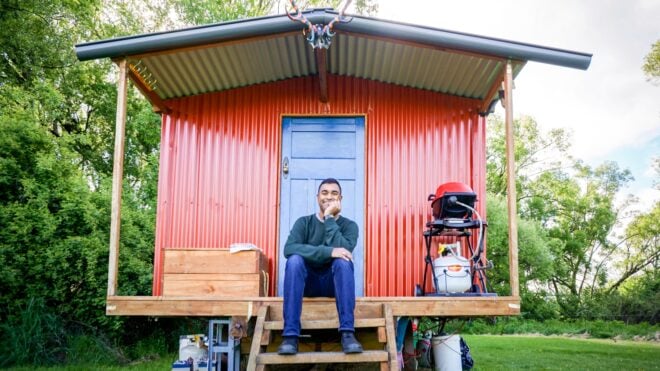I have to admit: I'm borderline paranoid when it comes to my kids' safety.
I used to read stories here and there about abductions and abuse, but it was not until I became a mom that I realized the magnitude of the problem. The other day my daughter went on a field trip, and it was torture for me. I was pacing back and forth all morning and, overall, pretty worried and anxious. (I blame Lifetime and its movies inspired by true stories.)
Anyways, I got a phone call at noon from the school. When I saw the number, my hands started shaking, I felt I couldn't breathe and, in those 10 seconds, a million awful scenarios went through my head. Turns out, she wasn't feeling well. But in that moment I was in such panic that I decided I needed to step up my game.
RELATED: The Price Kids Pay for Social Media Access
Did you know that more than 700 children are abducted every day? According to the National Center for Missing and Exploited Children, there were 466,900 entries for missing children in the U.S in 2014. Those are not counting kids that don't get reported, because they are thought to be runaways. These are minors, under the age of 18.
Hearing those stats is truly shocking. Imagine: those could be the children of your neighbors, coworkers or even your own. I can't even deal with that thought, and that's why I'm always so fearful.
We tell our kids the basic principles of safety: "Stranger danger", don't talk to anyone you don't know, always stay with your group during field trips, don't accept things from others, never open the door when you are home alone, ask for help if anyone bothers you.
But, there is so much more we could do to prevent our children from been harmed. Here's how to start:
1. Go beyond the basics
Teach your kids to be aware of their surroundings and to always trust their instincts. If they see someone unusual, they should let an adult know right away. That includes someone offering candy or showing puppies. If you are in a public place and a stranger sits next to you and casually interacts, this could give your child the perception that it might be someone they could trust. That is why, in my opinion, they should never trust anyone unless you verbally approve, even if they see you speaking to them.
2. Be detailed with instructions
Let your child know who can pick them up from school—or any other activity—in case you can't, so they know who they are allowed to go with. Tell them to never go with anyone, not even a parent of a friend, or anywhere, unless you have previously agreed to that. Sadly, most cases of abductions and molestation come from relatives or people that present themselves as someone who knows the family, so they can gain the child's trust. Please, always listen to your child even if what he/she tells you sounds outrageous or hard to believe. Assure your children they can trust you with anything.
I am a 30-year-old woman and, when I can't find my mom at a store, I do our whistle. We find each other right away. Katniss has got nothing on me!
3. Karate Kid 2.0
It sounds silly, but teaching our kids, including our grumpy teenagers, about self-defense can truly save their lives. Reassure them that, just like Ant-Man, they can be small but strong. This is the time that is OK for them to bite, scratch, low-blow, pinch, poke eyes, pull hair, stomp and scream as loud as possible. Remind them to never believe threats about someone being able to hurt you, if you don't agree to their demands. Coercion and guilt is a method used by abductors and child molesters to exercise control over children.
4. Safety in style
Don't let your child blend in when you're out and about. Neon and bright colors are great ways to keep an eye on your kid—or find them quickly. Someone trying to hurt them wants to remain unnoticed, and those attention-grabbing colors do exactly the opposite. Also, look into jewelry with GPS built in that can help you track your child's location in case of an emergency. Another thing is having your own mockingbird-style whistle. I am a 30-year-old woman and, when I can't find my mom at a store, I do our whistle. We find each other right away. Katniss has got nothing on me! Now, imagine how powerful this could be in a moment of distress.
5. Research your resources
First, go to your local police department and create a fingerprint card with a current picture. Always keep those in a safe spot and available in case of emergencies. Learn about the child molesters in your area. There are tons of free websites that give you the location of registered sex offenders and, I would say, go ahead and check their criminal record to know the charges. Even if you think your neighborhood is safe, there might be predators closer than you imagine. The first three hours after a child is taken are crucial. They can be the difference between life and death, so don't hesitate to reach out to the authorities to release an AMBER Alert. Review the steps and educate yourself about the process, just in case.
RELATED: Kids Should Not Go To the Restroom Alone
- Use technology
While you make sure the requirements are met for an AMBER Alert, find other resources. Blast it on Facebook, Twitter, Instagram. Trust me, it helps! The Lassy Project, inspired by the murder of 10-year-old Jessica Ridgeway is an app that uses GPS and crowd-sourcing to inform the local community about an abduction. John Guydon, CEO of the company, advises building a strong community. "Kidnapping a child that the entire community is watching out for is a bad idea," he says. "A great understanding of where and, most importantly, when a child is doing their daily activities is key. This way you can jump into action quickly when something is out of the norm. If it does, just go to the app and click escalate".
Image via Twenty20/RoseMorales-Badlani




